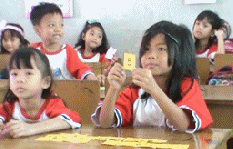Written By: Silvana N. S. (IMPoME students 2011)
(Adopted from”Developing A Learning EnvironmentOn Realistic Mathematics Education For Indonesian Student Teachers” by Prof. Zulkardi)
In Indonesia, many pupils still see mathemathics as a ghost. Furthermore, teachers make the already challenging subject that much harder for the pupils to learn. The teachers also still use teaching method based on teacher-centered instead of student-centered. Thus, the pupils are passive and simply copy what teacher writes on the black board. Same thing happen to the assessment process, it is not integrated in the instructional process but is provided at the end of the lesson. The problems used in assessment only focus on algorithm and procedures and they lack of practical applications. These problems can be catagorized to the lower level of thinking. One promising solution for all those mathematics education problems in Indonesia is RME (Realistic Mathematics Education).
RME is one of teaching and learning theories in mathematics education. This theory is invited and developed for the first time in Netherlands in 1970’s but in Indonesia it starts to be developed in 2000’s. It is strongly influenced by Hans Freudenthal’s concept of ‘mathematics as a human activity’ (Freudenthal, 1991). According to Freudenthal, pupils should not be treated as passive recipients of ready-made mathematics, but they should discover and reinvent mathematics by doing it themselves.
There are five characteristics of RME (de Lange, 1987; Gravemeijer, 1994):
- the use of contexts in phenomenological exploration;
- the use of models or bridging by vertical instruments;
- the use of pupils’ own creations and contributions;
- the interactive character of the teaching process or interactivity; and
- the intertwining of various mathematics strands or units.
In RME, the starting point of mathematics instruction should be experientially real to the student. This process will make them to: explore the situation; find and identify the relevant mathematical elements; schematize and visualize in order to discover patterns; and develop a model resulting in a mathematical concept. By a process of reflecting and generalizing, the pupils will develop a more complete concept. It is then expected that the pupils will subsequently apply mathematical concepts to other aspects of their daily life, and by so doing, reinforce and strengthen the concept.
In RME classroom, the teacher should:
- Facilitate pupils with a contextual problem that relates to the topic as the starting point.
- During an interaction activity, give the pupils a hint if they need help.
- Let the pupils find their own solution. This means that pupils are free to make discoveries at their own level, to build on their own experiential knowledge, and perform shortcuts at their own pace.
- Organize and stimulate the pupils to compare their solutions in a class discussion. Ask the pupils to communicate, argue and justify their solutions.
- Give other contextual problems.
In RME, the assessment functions not only in the margin of instruction, but it is also an integral part of the instructional process. According to De Lange (1987), there are five guiding principles of assessment in RME:
- The primary purpose of testing is to improve learning and teaching. This means that assessment should take place during the teaching-learning process in addition to at the end of a unit or course.
- Methods of assessment should enable the pupils to demonstrate what they know rather than what they do not know. Assessment can be conducted by using problems that have multiple solutions and can be approached using multiple strategies.
- Assessment should operationalize all of the goals of mathematics education: lower, middle and higher order thinking level.
- The quality of mathematics assessment is not determined by its accessibility to objective scoring. For that reason, the use of objective tests and mechanical tests should be eschewed in favor of assessments in which we can see whether pupils truly understand the mathematical concepts involved.
- The assessment tools should be practical, fit into the usual school practice.







Carma Sawka
January 16, 2012 at 3:43 am
Thanks for taking time to write this write-up. It’s been quite useful. It could not have come at a far better time for me! http://www.ctctradeshows.com